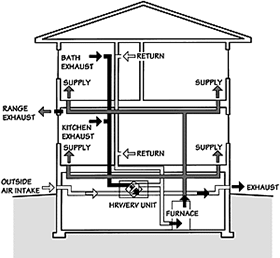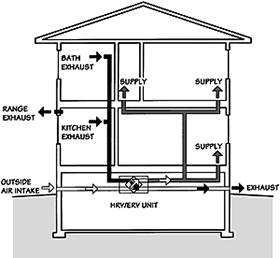Share
Related Topics
Tagged As
For the past two decades there has been mounting evidence that dependence on the natural exchange of air between the indoors and outdoors through air infiltration and exfiltration may not be satisfactory for good moisture control and indoor air quality. It also has become increasingly obvious that traditional ventilation methods, like opening a window or use of a common bath fan, are not providing adequate ventilation. A properly designed and installed ventilation system is the key to positive moisture control and will help ensure a healthy indoor environment for the occupant.
We do not strictly control Google ad content. If you believe any Google ad is inappropriate, please email us directly here.
Figure 1. Two options for fresh air distribution with a mechanical ventilation system.

Option 1. If connected to a forced air heating/cooling system, intermittent operation of a fan is required for distribution.

Option 2. Primarily for use in homes without a forced air heating or cooling system.
The most common HRV/ERVs are duct-connected house units. Other types of HRV/ERVs are wall or window room units. These are more often found in multifamily dwellings than in single family dwellings. The duct-connected units are more effective because they provide for a better distribution/pickup of air. The fan component of the duct-connected system is commonly installed in the utility or furnace room. It should be easily accessible for regular cleaning, air filter replacement, and servicing.
Frequently Asked Questions
Who needs an HRV/ERV?Every home (new and old) needs ventilation to bring in fresh air, to remove stale air, and provide moisture control. Since July, 1999, new homes constructed in Minnesota have been required to have a mechanical ventilation system to supply outdoor air for the people inside the home. An HRV/ERV is one mechanical ventilation system that offers convenience, comfort and building durability. In new construction, the connections should be roughed in if, for budget reasons, you do not install the HRV/ERV during construction.
Where do I go to buy an HRV/ERV?
A good mechanical contractor is the key to success. If you are building a new house or remodeling, ask your building contractor about the mechanical ventilation options or check the yellow pages for heating and cooling contractors. A contractor experienced in ventilation should be able overcome any obstacles related to the installation. This would include balancing the system and verifying flow to all pickup points and insuring proper application, i.e., sizing, location of inlets and outlets, and zone control.
How much does it cost to install an HRV/ERV?
Costs can vary a lot depending on the type and complexity of the installation, as well as on the size and features of the HRV/ERV. For new construction, the costs would normally run from $1,000 to $2,500. It will generally cost more for a retrofit, due to the difficulty of running ductwork to the source points. Volume (or non-source point) ventilation systems can be installed at a lower cost, but may not be as effective and will require the furnace fan to run continuously.
General Design Considerations
- Locate the fresh air intake away from driveways and laundry and furnace vents.
- Install a supply inlet (dedicated inlet or heating register, if connected to forced air) for each bedroom and one for each common area.
- Install a return outlet in each high moisture area such as the kitchen, utility room and bathroom.
- Return outlets (pick up points) should be within one foot of ceiling and 10 feet away from an oven or cooktop, as vaporized grease could clog the energy recovery core.
- Keep duct runs as short and straight as possible.
- Use smooth, round ductwork when possible.
- Insulate intake/exhaust and any ventilation ducts in unheated spaces and seal all joints.
- Install a drain to catch any condensate, if required.
Will operating costs increase my electric, heating or cooling bill?
An HRV/ERV requires service and electricity to run the fan but it provides an opportunity for heat recovery. All homes need ventilation air that must be heated in winter and may be cooled and dehumidified in summer. John Bower (1995)1 calculated the cost for 80 CFM of continuous balanced ventilation in several U.S. cities, including Minneapolis, Minnesota, with and without heat recovery. A typical annual cost of 80 CFM of continuous ventilation was calculated at $86 with heat recovery and $188 without heat recovery. Of these amounts, approximately $42 is the cost of the electricity to run the 60 W fan).2 Systems requiring the furnace fan to run continuously will have additional costs for operation. Continuous operation of a typical furnace fan for heating or cooling and circulation would range from $0.40 to $1.00 per day.
How does the heat and moisture transfer of an HRV/ERV work?
The incoming fresh air is tempered with a heat or energy recovery core. Heat is exchanged through a core that is frequently made of multiple plates of aluminum or plastic. Water vapor is transferred with a rotating wheel with desiccant material or permeable plates.
Models with heat recovery only transfer heat from the exhaust air stream to the incoming air stream in the heating season and from the incoming air stream to the exhaust air stream in the air conditioning season. Models with heat recovery and moisture recovery transfer heat and moisture from the exhaust airstream to the incoming air stream during the heating season, and transfer heat and water vapor from the incoming air stream to the exhaust air stream during the air conditioning season.
What options and features are available?
- Heat recovery with and without moisture transfer3
- Defrost control or preheater system to prevent ice buildup on the recovery module (should be a standard in cold climates)
- Single or multiple speed controls (standard on many units)
- Pollutant sensor controls (central control with high speed override)
- High efficiency air filter on incoming air
Discuss these options with your mechanical contractor.
How can I compare the performance of different models?
Systems are tested and rated for performance. An independent organization such as the Home Ventilation Institute (HVI) should certify tests and ratings. You can compare these performance ratings for:
- Airflow capacity in cubic feet per minute (CFM)
- Recovery efficiency of the energy recovery core (heat and/or moisture)
- Sound (noise) level in sones
You can also compare the warranty coverage on installation and parts such as fans, cores, and controls.
What size HRV/ERV do I need?
New homes must comply with the Minnesota Energy Code. The mechanical ventilation requirement is for airflow and does not require energy recovery. It is based on the number of bedrooms with a minimum airflow of 15 CFM/bedroom + 15 CFM and a total ventilation capacity equal to 0.05 CFM/square foot. Additional ventilation may be required for special needs such as crafts/hobbies and excessive moisture generated by the occupants or by foundation moisture.4
Do I still use a bath fan?
It depends on HRV/ERV duct design, bathroom airflow requirement, and manufacturer’s guidelines.
Do I still use a kitchen exhaust fan? What if I have a “high CFM” fan?
A kitchen exhaust fan is still needed to remove grease and combustion gases. High capacity kitchen exhaust systems (downdraft or range hood with an airflow of greater than 250 CFM) present problems with natural draft combustion appliances and separate makeup air will be needed.
In the summer do I need to use a dehumidifier or air conditioner with an HRV/ERV?
If your unit exchanges moisture, you may not need a dehumidifier. While an HRV/ERV will reduce the cooling load added by the ventilation, it will not eliminate the need for an air conditioner.
In winter can my house get too dry?
If it gets too dry you may need to use a humidifier or temporarily reduce the airflow. Dryness is more likely to happen if the unit exchanges heat but not moisture. You may wish to discuss this with your contractor.
What will I need to do to maintain a system?
Check the owner’s manual. Typically maintenance can be done by the homeowner and includes the following:
- Clean or replace air filters every 1-3 months.
- Clean or unblock outside hoods and screens every 13 months.
- Clean the energy recovery core every 6 months.
- Clean condensate drain and pans every 6 months.
The homeowner should also service (oil if needed) and clean fans every 3-6 months, and annually clean grills and inspect ductwork for any leaks or obstructions. In addition, a professional should annually check the system and verify that the system is properly balanced.
1Bower, John, 1995.
2Assumptions were: heating with natural gas @ 80% efficiency; cooling with a 10.0 SEER air conditioner; operating a 60 W fan continuously; natural gas costing $0.60/ccf; electricity costs $0.08kWh; dehumidification cost being 30% of cooling cost; and an HRV having 70% efficiency.
3For smaller homes (which usually means lower airflow rates and/or high moisture generation), moisture transfer may not be a desirable option in the winter in cold climates.
4For a 1,600 sq.ft., 3 bedroom home: the continuous ventilation requirement would be: (3 bedrooms x 15 CFM/bedroom) + 15 CFM = 60 CFM. The total ventilation capacity must be at least: 1600 sq.ft. x 0.05 CFM/sq.ft. = 80 CFM; therefore the system must have a minimum ventilation capacity of 80 CFM.
Resources
Bower, John, 1995. Understanding Ventilation. The Healthy House Institute.
Home Ventilating Institute. Wauconda, IL 60084.
Minnesota Builder (May/June 1998) St. Paul, MN: Builders Association of Minnesota.
Minnesota Department of Administration, State Building Code Division. Minnesota State Building Code, Minnesota Rules Chapter 7672.
Authors and Acknowledgments
Pat Huelman, Associate Professor, Wood and Paper Science
Wanda Olson, Professor, Design Housing and Apparel
The authors wish to acknowledge Mike Wilson and Steve Klossner for their contributions and John Carmody for illustrations in Figure 1.

Copyright © 2008 Regents of the University of Minnesota. All rights reserved.
HHI Error Correction Policy
HHI is committed to accuracy of content and correcting information that is incomplete or inaccurate. With our broad scope of coverage of healthful indoor environments, and desire to rapidly publish info to benefit the community, mistakes are inevitable. HHI has established an error correction policy to welcome corrections or enhancements to our information. Please help us improve the quality of our content by contacting allen@healthyhouseinstitute.com with corrections or suggestions for improvement. Each contact will receive a respectful reply.
The Healthy House Institute (HHI), a for-profit educational LLC, provides the information on HealthyHouseInstitute.com as a free service to the public. The intent is to disseminate accurate, verified and science-based information on creating healthy home environments.
While an effort is made to ensure the quality of the content and credibility of sources listed on this site, HHI provides no warranty - expressed or implied - and assumes no legal liability for the accuracy, completeness, or usefulness of any information, product or process disclosed on or in conjunction with the site. The views and opinions of the authors or originators expressed herein do not necessarily state or reflect those of HHI: its principals, executives, Board members, advisors or affiliates.








